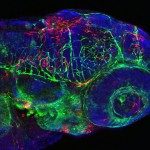Lien vers Pubmed [PMID] – 10953016
J. Cell Biol. 2000 Aug;150(4):921-8
Mammalian genomes feature multiple genes encoding highly related keratin 6 (K6) isoforms. These type II keratins show a complex regulation with constitutive and inducible components in several stratified epithelia, including the oral mucosa and skin. Two functional genes, K6alpha and K6beta, exist in a head-to-tail tandem array in mouse genomes. We inactivated these two genes simultaneously via targeting and homologous recombination. K6 null mice are viable and initially indistinguishable from their littermates. Starting at two to three days after birth, they show a growth delay associated with reduced milk intake and the presence of white plaques in the posterior region of dorsal tongue and upper palate. These regions are subjected to greater mechanical stress during suckling. Morphological analyses implicate the filiform papillae as being particularly sensitive to trauma in K6alpha/K6beta null mice, and establish the complete absence of keratin filaments in their anterior compartment. All null mice die about a week after birth. These studies demonstrate an essential structural role for K6 isoforms in the oral mucosa, and implicate filiform papillae as being the major stress bearing structures in dorsal tongue epithelium.

